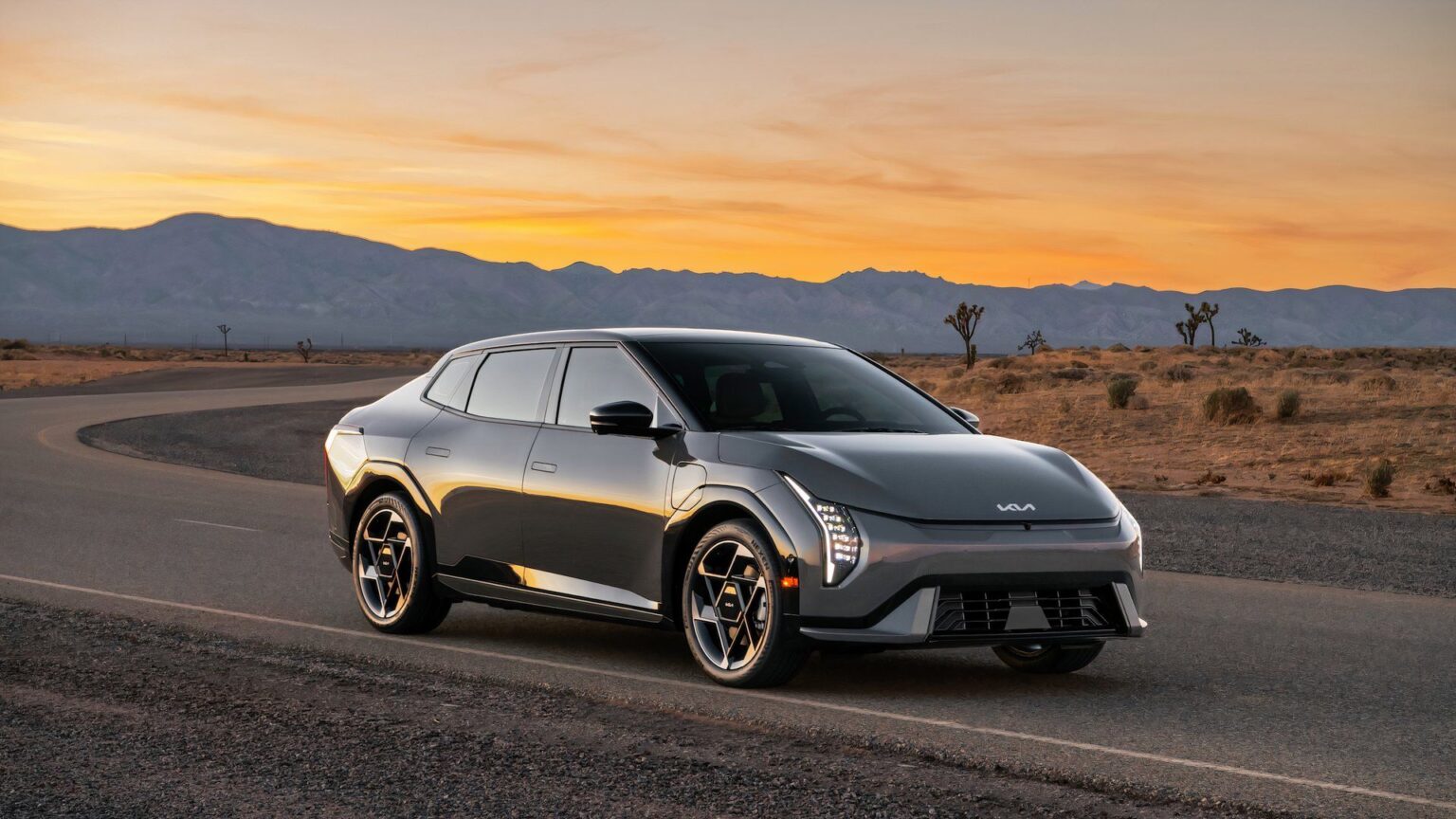While Kia showed off the EV4 in Spain recently, this is the first time we’ve gotten to see the car in the U.S., and the first time we have as much specification detail. The new EV4 will be Kia’s cheapest electric car in the U.S., and it’s clearly directly aimed at the forthcoming 2026 Nissan Leaf and Chevy’s revised Bolt. What we know about the new, smaller (and presumably more affordable) EV from Kia that debuted at the New York International Auto Show today, follows here.
Rear-Wheel Drive, Who Dis?
The EV4, unlike the EV6, has a base-model setup that’s front- rather than rear-wheel drive. While that’s pretty commonly the norm in gas cars that only drive a single axle, a lot of EVs, including from Kia (and the Hyundai Group) have used rear-wheel drive as the default.
Here, the single motor powers the front wheels rather than the rears, which is less ideal if you’re a performance fan. And even though this isn’t billed as a performance car, EVs with instant torque tend to overpower their front wheels more readily, so it will be interesting to see how this car drives once it’s out. The GT-Line version isn’t going to offer more than the standard 201 HP, however, only more range and some stylistic panache.
But think about hitting the peak horses of any front-wheel-drive gas car, no matter how anemic. That tends to induce torque steer and other issues, so it’ll be interesting to see how Kia tames this, while still delivering enough mojo.
Good-ish Range
If Kia is to sell this car at an affordable price range (they actually used the word “affordable” in their press release) they clearly have to make some compromises. One way was to shrink the base battery size to 58.3 kWh. But they’re still expecting an okay 235 miles of range, in part because they’ve achieved a super-slippery .23 coefficient of drag (Cd).
That’s not as amazing as the .21 Cd of its cousin, the Hyundai Ioniq 6, but it’s not too shabby, and Kia got there by running a complete underbody cover. They’re also offering the car with aerodynamic wheels, which is clearly to help eke out as much distance as possible between charges. Longer-range Wind and GT-Line cars get a bigger, 81.4 kWh battery that Kia says will be good for 330 miles of range.
Tech Features We Want — And Don’t
Kia says the car will get in-vehicle gaming tech (maybe cool?) and the ability to charge small electronics, ranging from laptops to lighting. That doesn’t sound like a standalone ability to work as a home backup generator, which is emerging as a pretty big selling point for EVs.
We’re also not so thrilled about the fact that the EV4 has (based on what we’ve seen) barely any hard switchgear. There are some haptic switches in the center console above the center vents, and a volume wheel, but it looks like the rest of the controls are buried in the instrument tablet.
What is good is that even though the EV4 is on the less robust, 400V rather than 800V architecture, Kia says the car can go from a 10- to 80-percent state of charge on fast charging in 29 or 31 minutes (depending on battery size). We’re also happy to see the car gets a standard North American Charging Standard (NACS) port.
More Tech Trickling Down
We should mention some real pluses to the EV4’s suite of tech. Kia is giving the car’s owner the chance to remotely control climate, charging and other functions, including locking and unlocking from their phones. Owners can also customize their cars’ home screen with a personalized image, and its bringing some luxury-car tech to the EV4, including an acoustic windshield (basically, thicker glass, to make the cabin quieter), standard dual-zone automatic temperature control, and, as options, heated and cooled front passenger seats and a heated steering wheel.
Kia is also selling the car with Advanced Driver Assistance Technology, which reads speed limit signs and can automatically adjust the EV4 to the designated road speed, and adapt to other vehicles on the road via adaptive cruise control.
TopSpeed’s Take
The other shoe to drop is that we’re only getting the sedan version of the EV4, while other markets will get the hatchback. This, even though the EV6 is a hatchback and better for it, because it’s far roomier and more useful as a result. And Americans love hatchbacks, because we buy SUVs by the millions, and, let’s face it, SUVs and crossovers have hatches, not trunks.
A further problematic twist when it comes to affordability is that, at least right now, the car is designated to be made in Korea, not the U.S. It’s not supposed to go on sale in the U.S. until early 2026. A lot can happen between now and then with tariffs (or, you know, in the next five minutes), but as it currently stands, a Korean-made EV meant to be “affordable” could suddenly be 25-percent more expensive.
That’s bad news if the point of the EV4 is an affordable EV to compete with the likes of the next Chevy Bolt and the next Nissan Leaf.
Read the full article here


